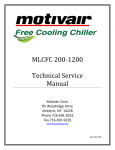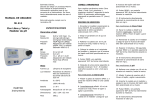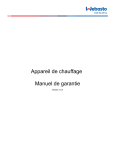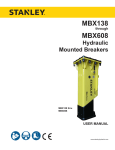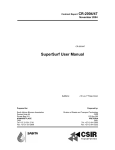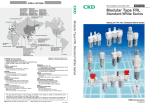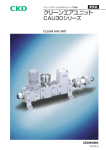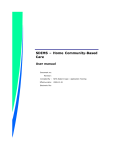Download Thomas & Betts EPW User's Manual
Transcript
Electric, Water Circulation Heater Applies to Heater Model EPW 1.0 INITIAL INSPECTION Installation/Operation/Maintenance Form MI511 Figure 1 DIMENSIONS HOLDING BOLTS FOR BRACKET 29" 1.1 Upon receipt from the carrier, inspect the heater for possible damage in transit. If necessary, immediately report damage to shipping company. 1 1/2" OUTLET 11 3/4" 1.2 Verify that the nameplate voltage, phase, wattage and catalog number comply with the order. 1 1/2" INLET 15" 22 1/2" 1.3 The EPW, when configured: • as a swimming pool heater, has a catalog number EPWP; • as a domestic water or dishwasher water booster heater, has a catalog number EPWD; • as a hot water furnace for comfort or process water heating, has a catalog number EPWH. These units differ in trim package, i.e. auxiliary controls. For this reason IT IS IMPORTANT THAT THE UNITS BE USED ONLY FOR THE SPECIFIC APPLICATIONS AS STATED ABOVE. 2.0 INSTALLATION 2.1 The heater must be installed by qualified personnel to code requirements. 2.2 Ensure that the electrical power supply is the same voltage and phase as the heater with sufficient current capacity. 2.3 The heater must be installed in a horizontal position with the outlet at the top and the drain at the bottom. 2.4 The mounting hardware, as provided, is suitable for either floor or ceiling mounting. Note that each mounting bracket is to be attached at the top of the heating housing by two holding bolts (see Fig.1). Remove the two bolts and install the first mounting bracket prior to removing the second two bolts to install the second mounting bracket. If all bolts are removed at once the tank may shift which will increase installation time. 2.5 Please refer to Figure 1 for dimensions. Be sure to provide adequate space to facilitate installation and maintenance. Leave a minimum of 24" (60cm) clearance at the control compartment (opposite side to the inlet). If the unit is to be mounted under a table or cabinet a minimum of 30" (75cm) from the floor to the underside of the cabinet is required for piping. Knockouts 1", 1 1/4", 1 1/2 & 2" 10 3/4" 7 1/2" 1 1/2" DRAIN 7 1/2" 16 1/4" 4" 15" 2.6 Allow space at sides for the conduit used for power supply and for thermostat or optional equipment wiring. 2.7 Please refer to Figure 2 for component location and note the following: 2.7.1 The circulation pump outlet is connected to the heater inlet located at the end of the unit opposite to the controls compartment. 2.7.2 A flow switch (optional) is to ensure that the heater will not be energized if the flow is interrupted. Installations requiring a flow switch include: (a) Swimming pool heating systems where the heater is positioned above the pool water surface. (b) Whenever the plumbing allows for the heater to be isolated by shut off valves on the inlet and outlet. (c) Systems where the heater vessel is allowed to drain when flow is interrupted. (Without water the built-in limit will not perform as intended). (d) Systems where the temperature control bulb is located away from the outlet. If a flow switch is not used, and also for pool heating, it is best to allow the circulating pump to run continuously. 2.7.3 Wire both flow switch and control thermostat to contacts designated "normally open" and "common". "Normally open" contacts open on temperature rise on thermostat and close on flow through switch. 2.7.4 A pressure relief valve is a safety feature which is intended to open when the system malfunctions or is improperly operated or maintained. Units equipped with a pressure relief valve should be fitted with piping to direct the discharge down and away from personnel or equipment. NEVER INSTALL A SHUT OFF VALVE ON EITHER SIDE OF A PRESSURE RELIEF VALVE. Figure 2 TYPICAL INSTALLATION Control Fuse *N.B. WHERE THERMOSTAT BULB IS LOCATED OTHER THAN OUTLET, FLOW SWITCH IS RECOMMENDED. 2.7.5 Optional expansion tank (for closed loop systems) is mounted in the outlet piping. 2.7.6 A 1 1/2" NPT drain plug is fitted at the bottom of the heater. We recommend use of a drain valve to simplify clean-out of sludge which may accumulate in the vessel. Sludge build-up can cause heating element failure. 2.7.7 For flow rates greater than 50 gpm, to reduce tank erosion, a bypass loop with regulating valve is recommended. 2.7.8 Closed loop systems require an air bleed valve, preferably installed at the highest point in the piping loop. 3.0 START UP AND OPERATION 3.1 The EPW heater is designed to heat water in a non-hazardous environment. In some closed loop systems chemically stabilized ethylene glycol may be added to the water for freeze protection or to elevate the boiling point. If you are unsure as to suitability of glycol to your heating loop contact the factory. 3.2 Check the electrical system for loose connections and tighten if required. 3.3 After all piping is installed turn the thermostat to its lowest setting and operate the circulating pump for up to 1/2 hour to check for leaks and to remove air pockets. In closed loop systems use the air bleed valve to remove entrapped air. An air lock in the heater vessel could cause the heaters to run dry and fail prematurely. 3.4 Set the thermostat to the desired temperature. The temperature rise through the unit will depend on the flow rate and the heater kilowatt (kw) rating. For water: GPMUS = 6.83 kw Temp. Rise (°F) Example: For a 30 kw heater and a 10°F temperature rise the flow required in U.S. gallons per minute is: GPMUS = (6.83)(30) 10 = 20.4 Adjust the thermostat differential to give the desired cycling rate. It is best to use the maximum acceptable differential so as to minimize cycling and prolong component service life. However, if the system requires close control a narrow differential setting will be necessary. 3.5 For systems using a by-pass loop, open the by-pass valve to reduce the load on the pump but not enough to cause the limit thermostat to open. For pool heating, the ideal bypass opening will result in water leaving the heater at not more than 90°F. 3.6 The built-in temperature high limit is factory set at 180°F (82°C). This control works best when it is set about 40°F (22°C) above the water outlet temperature. To adjust the limit control setting remove the small panel on the limit control to access the adjustment screw. Under normal operation the heater should not cycle on the limit control. Figure 4 Accessories Protective Well CWI-6 1/2" NPT 3.7 If the limit trips it must be manually reset before the heater will operate. Prior to reset, the condition(s) which caused the trip shall be corrected. 4.0 MAINTENANCE 5' (1.5m) Capillary 4.1 Service to the unit shall only be done when the power is disconnected at the mains. 4.2 After the first few days of operation, and periodically thereafter, inspect for piping leaks and loose electrical connections. 4.3 The EPWD unit, because it is used in an open loop water heating system, may be subject to sludge build-up if the water is hard and untreated. This unit must be drained at regular intervals (depending on water conditions and operating time) to remove sludge. Once a year a flange heater must be removed and the vessel inspected and cleaned as required. Local conditions may cause this inspection time to vary. Thermostat 11B06-1 Control Circuit Fuse: 208 & 240V: 2 x MDA 3, 3 AMP, 277 to 600V: 1 x MDA 5, 5 AMP Figure 3 Wiring Diagram 3φ 1φ Disconnect Switch (not supplied) To Remote Thermostat (supplied loose) TYPE F61KB FLOW SWITCH (Optional) N.B. REMOVE JUMPER IF OPTIONAL FLOW SWITCH IS USED.



